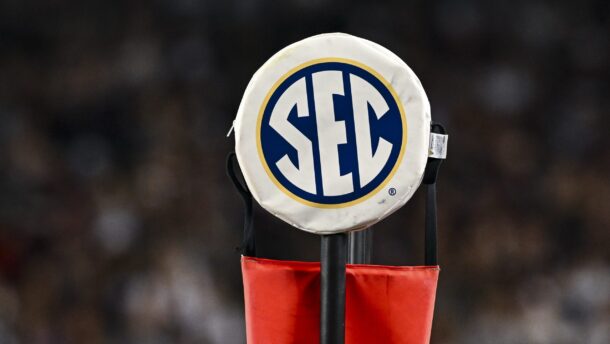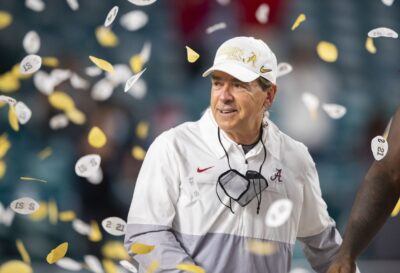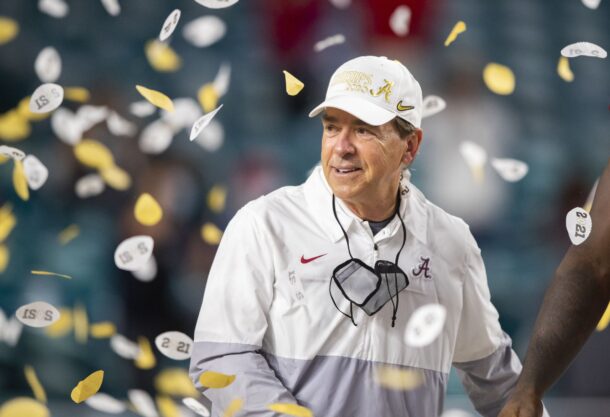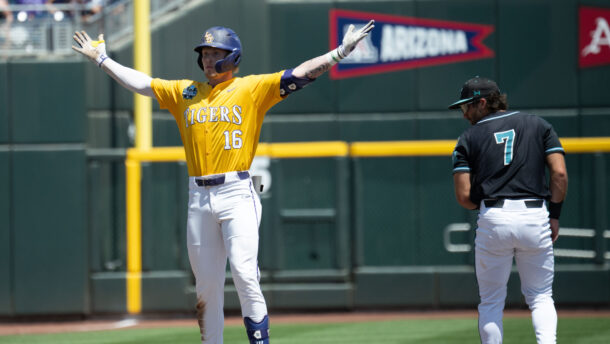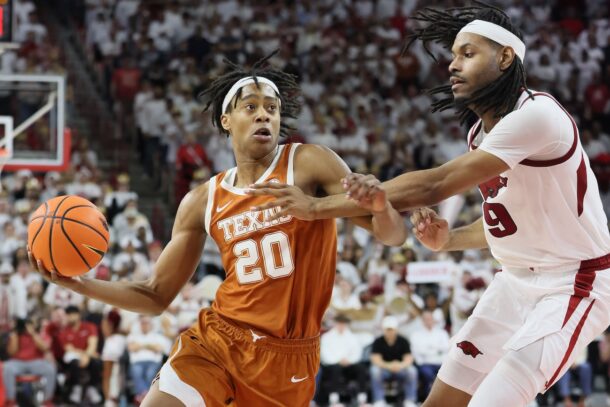
1 clear weakness for every SEC basketball team entering the home stretch
The SEC basketball season will draw to a close next weekend with the final games of the regular season.
As the postseason nears, we now have a relatively-significant sample size of data to analyze for all 16 teams. At least 14 teams are still alive for NCAA Tournament consideration as well entering the final week.
Last week, we broke down 1 clear strength for every SEC basketball team. Now, it’s time to take the opposite approach. Here’s 1 weakness for each team in the SEC entering the final week of the regular season:
Alabama: 3-point shooting
Frankly, Alabama’s more-obvious weakness is defensive turnover rate. The Crimson Tide rank 349th nationally in that category as of Sunday, per KenPom. That’s obviously terrible, but here’s the thing: Alabama was bad in that area a year ago, too, and it still made the Final Four. In fact, Alabama has generally been pretty terrible at forcing turnovers throughout the Nate Oats era.
The main difference between last year’s team and this year’s team is 3-point shooting. Alabama finished last season ranked 19th nationally in 3-point percentage. The Crimson Tide are currently well outside the top-100 in that category for 2024-25. Mark Sears, Grant Nelson and Labaron Philon have all had disappointing seasons from beyond the arc. Chris Youngblood and Aden Holloway are great shooters, but they’ve struggled more on the defensive end.
The triumvirate of Sears, Youngblood and Holloway have a raw defensive rating of 109.4 in 295 possessions on the season, per EvanMiya.com’s lineup data. That’s a really rough number — if extrapolated over the full season, that defensive rating would rank outside the top-250 nationally. When you can’t play your 3 best shooters at the same time without your defense cratering, it’s difficult to survive in March. That’s especially true when you’re top-30 in 3-point attempt rate (as Alabama is) and only 1 player (Holloway) is making 3-pointers at a rate higher than 39% (min. 50 attempts). Given that the rest of Alabama’s profile (tempo on offense plus lack of turnover creation on defense) relies on elite 3-point shooting, that’s the Tide’s biggest issue right now.
Arkansas: Offensive rebounding
Arkansas’s statistical profile doesn’t stand out in too many ways. The Razorbacks aren’t elite at anything (aside from rim protection, perhaps) but they aren’t terrible in too many areas, either. One unmistakable weakness for Arkansas is offensive rebounding. The Hogs are 271st in offensive rebounding rate this season and 14th in that category in SEC play.
Frankly, this is unusual for a John Calipari program — particularly in recent years. His Kentucky team led the country in offensive rebounding rate as recently as the 2023 season. The Wildcats were also top-5 in 2022. Long-term, this likely won’t be an issue for Arkansas. But in March Madness, should Arkansas get there, it definitely looks like an area that can be exploited.
Auburn: Defensive free throw rate
It’s pretty difficult to pinpoint a weakness for this Auburn team, which might have a case as the most dominant SEC squad of all time. The Tigers currently have an adjusted net rating of +37.63 on KenPom, which is higher than the 2015 Kentucky team (+36.91) that went 38-1.
With that being said, Auburn does rank 316th nationally in defensive foul rate at this stage in the season. Of the 4 factors, foul rate is the least-important one, so this is not a massive red flag by any means. But it’s clearly shown up at times this season. Duke took 27 free throws when it beat Auburn earlier this season, for example. Keep an eye on this in the later rounds in March Madness as Auburn’s margin for error gets smaller.
Florida: Free throw shooting
Florida’s offensive profile is excellent overall, especially when factoring in opponent strength. But Florida has endured issues at the foul line this season, which could be a problem if the Gators get into a tight game in the postseason. Florida ranks poorly in both free throw percentage (218th) and free throw attempt rate (232nd) this season.
This is an issue that has loudly showed up in Florida’s 4 losses this season. The Gators shot a combined 65.8% from the charity stripe in defeats to Kentucky, Mizzou, Tennessee and Georgia. The Tennessee game got out of hand early. But Florida’s other 3 losses this year came by a combined 12 points. Florida missed a whopping 34 free throws in those 3 contests. If UF loses a stunner in March, the free throw line will likely be a big reason why.
Georgia: Turnovers
Georgia is one of the worst teams in the country when it comes to ball security. The Bulldogs rank 301st in offensive turnover rate this year and 353rd in offensive steal rate. That’s a recipe for disaster any way you slice it.
Georgia does get some of those possessions back on the offensive glass (17th nationally in offensive rebounding rate) but it hasn’t been enough this season. With the notable exception of freshman forward Asa Newell, every other Georgia player has a turnover rate above 15% so far this season.
Kentucky: Defense
Kentucky has too many issues on defense to single one out. The Wildcats surprisingly rank in the top-70 in KenPom’s adjusted defensive rating metric for the season, but there are just so many problems here that are capping the ceiling for this Kentucky team.
Most notably, Kentucky is 342nd in defensive turnover rate. Mark Pope’s teams never force many turnovers — not great, yet recoverable with the right profile in other areas. But Kentucky also concedes a ridiculous amount of 3-point attempts (322nd in 3-point attempt rate) and has a porous defense from inside the arc (277th in 2-point field goal percentage defense). Per CBB Analytics, Kentucky is about 5-6% worse than the Division I average at defending both the rim and mid-range areas.
Kentucky’s 1 defensive strength this season has been 3-point efficiency (22nd), but even that has been a problem recently. The Wildcats have had 5 games since the start of February where they’ve allowed double-digit makes from beyond the arc. In 3 of those games, opponents made north of 43%. That’s not a great trend for a team that gives up such a high number of 3-point attempts per game.
LSU: Defensive rebounding
LSU is arguably the worst team in the SEC this season. The Tigers were pretty good throughout nonconference play, but have largely been exposed during SEC action. They’re inefficient and ineffective across the board on both sides of the floor.
But the biggest, most-glaring weakness for LSU this season is on the defensive glass. For the season, the Tigers 348th nationally in defensive rebounding rate. They allow opponents to corral 34.6% of available offensive rebounds. In SEC play, that number has further ballooned to 37.3% — worst in the conference. LSU has a lot of issues to sort out under Matt McMahon in the future, but this is a big one.
Mississippi State: The 3-point line
Mississippi State has been destroyed at the 3-point line this season on both sides of the floor. Offensively, the Bulldogs make just 31.2% of their long range tries. Defensively, they’ve allowed teams to shoot more than 36% from beyond the arc. The disparity between those numbers has grown during SEC play as well.
The result is that Mississippi State makes 2.9 fewer 3-pointers per game than its opponents during SEC play. That’s like starting every game in a 9-0 hole. Mississippi State has been -6.1 in that category on average in its 8 SEC losses this season.
Mizzou: 2-point defense
Mizzou has been lost in the wilderness a little bit since its big win over Alabama a couple of weeks ago. It’s lost 2 of 3 games since then to weaker opposition in Arkansas and Vanderbilt. But even dating back to before that win over the Tide, 2-point defense has been an issue for Mizzou.
In its last 5 games, Mizzou is allowing teams to shoot 64.3% from 2-point range. That’s 363rd nationally out of 364 teams since Feb. 15, per BartTorvik. Only Purdue is worse. Dennis Gates and his staff have to get that ironed out in a hurry if the Tigers are going to make a run in March.
Oklahoma: Maximizing offensive possessions
There are 2 key areas where teams can excel in an effort at winning the possession battle over the course of a game: rebounds and turnovers. Offensively, the Sooners struggle in both categories. During SEC play, Oklahoma ranks 15th in the league in both offensive rebounding rate and offensive turnover rate.
The result is a lackluster offense for the Sooners. Despite being 6th in effective field goal percentage during SEC play this season, OU’s offense is 12th in adjusted offensive rating per KenPom. Without all those wasted possessions due to turnovers — or perhaps a few more gained on the offensive glass — Oklahoma would likely be nowhere near the bubble right now.
Ole Miss: 3-point defense
The Rebels are actually pretty solid when it comes to getting opposing teams to miss from beyond the arc. The problem is that Ole Miss conceded a very high rate of 3-point attempts, thus leaving them vulnerable to a hot shooting game if things break the wrong way.
Ole Miss ranks 308th in 3-point attempt rate defense, per KenPom. We’ve seen this issue bear out frequently in its losses this season. Teams are shooting almost 39% from 3-point range against Ole Miss this season in its losses. In wins? That number is below 30%. Ole Miss looks like a team that’s way too dependent on 3-point variance from its opponents as March Madness nears.
South Carolina: Offense in general (and wasting Collin Murray-Boyles)
South Carolina’s offense has been putrid all year. The Gamecocks rank dead last in the SEC in the following offensive categories: effective field goal percentage, turnover rate, 3-point percentage, 3-point attempt rate and steal rate. That’s to say nothing of the other offensive categories like 2-point percentage and block percentage where South Carolina is merely bad rather than the worst in the entire conference.
The exception, of course, is Collin Murray-Boyles, who should probably be getting All-America love despite South Carolina’s overall incompetence. Murray-Boyles has a true shooting percentage of 64% while also averaging over 8 rebounds and 2.9 steals + blocks per game. He’s 1 of 3 players in the entire country who can say that. Only 47 players have accomplished that feat since 2015. The list includes college basketball royalty such as Zion Williamson, Chet Holmgren, Keegan Murray, Evan Mobley, Oscar Tshiebwe, Trayce Jackson-Davis and Johni Broome, among others. Come to think of it, South Carolina’s biggest weakness is wasting this special season from Collin Murray-Boyles.
Tennessee: 2-point percentage
Tennessee’s profile on both sides of the ball is close to flawless, but the Vols could be more efficient from inside the arc. That’s not super surprising given that the Vols spend a ton of time with a 5-9 point guard on the floor in Zakai Zeigler. During SEC play, Tennessee’s 2-point field goal percentage has dipped to 48%, which ranks 15th.
Per CBB Analytics, Tennessee has shot the ball well below average on mid-range attempts and in the paint (non-rim) during both January and February. In those areas, the Vols are shooting well under 40% since the start of conference play. The Vols were also well below average at the rim in January. Chaz Lanier and Jordan Gainey are both hovering around 40% on mid-range attempts during SEC play, per BartTorvik, but everyone else is well below average. No one is particularly efficient at the rim, either. Tennessee must figure out how to get better looks in the half court, particularly since it runs one of the slowest-paced offenses in the nation.
Texas: Shot diet
Texas has an interesting profile on offense. The Longhorns have a borderline-elite scorer in Tre Johnson and one of the most athletic forwards in the league in Arthur Kaluma. The offense should be pretty good with those 2 alone, and that’s before factoring in the rest of the talent on this roster. But the shot diet is a serious anchor and looks like a big reason why the Longhorns may not make the NCAA Tournament this season.
Texas only takes about 36% of its overall field goal attempts from beyond the arc. That 3-point attempt rate ranks 14th in the SEC and 259th nationally for the full season, per KenPom. Texas simply isn’t taking enough 3-pointers — at least not from its best players. Johnson and Kaluma are 2 of just 4 players in the SEC this season who have attempted 175 2-point shots while also shooting at least 38% from 3-point range on the season.
Johnson is 5th overall in the SEC in 2-point tries with 251. That’s more than every center in the SEC except for Johni Broome. Johnson is decent from mid-range, making 42% on the year per BartTorvik. But 39% of 3 is worth a heck of a lot more than 42% of 2. Kaluma, meanwhile, is dreadful from mid-range at just over 28% this season. The rest of the Texas roster isn’t really built to be taking a high volume of 3-point attempts (although Jordan Pope has done so successfully in the past). That’s a problem for next season, though.
Texas A&M: Shooting
In 2025, the most important factor in whether or not you lose a game is shooting. Effective field goal percentage is a pretty obvious weakness for this Texas A&M team, which is highly unusual for a squad that’s rated this highly this late in the season. Over the last decade, there have only been 8 power-conference teams to win more than 56% of their league games with an effective field goal percentage below 47%.
Texas A&M has lost 4 consecutive games and looks like it will be limping into the postseason. The Aggies are the best team in the country when it comes to offensive rebounding, but that can only cover up so many flaws. Wade Taylor and Zhuric Phelps are A&M’s most influential offensive players. A little under half of A&M’s shot attempts come from 1 of those 2 guards. Neither has a true shooting percentage above 53% or a 3-point percentage above 33% on the year. That’s a difficult life to live, as A&M has found out over the past couple of weeks.
Vanderbilt: 3-point defense
Vanderbilt appears to be on track to making the NCAA Tournament after winning 3 straight games vs. teams in KenPom’s top-30. It’s no coincidence that this hot streak comes right as the Commodores are in their best stretch of 3-point defense since early in the season. In Vandy’s last 3 games, it has held opponents to 34.7% from beyond the arc. That number being a positive should underscore how dreadful Vandy has been at defending the 3-point shot this season. During SEC play, Vandy is dead last with an opponent 3-point percentage of 39.7%.
Knocking off that extra 5 percent or so over the past couple weeks will likely be the difference in Vandy making the NCAA Tournament or not. The Commodores won those 3 games by a combined 11 points. One even went into overtime. The margin on those victories was razor-thin.
This is still very much a weakness and not something that Vandy has “solved” by any means. The Commodores have not held an opponent under 30% from the 3-point line since its SEC opener against LSU back on Jan. 4.
Spenser is a news editor for Saturday Down South and covers college football across all Saturday Football brands.
